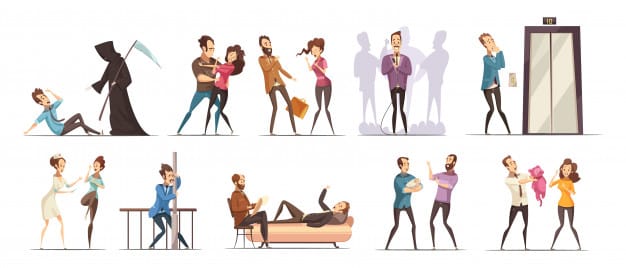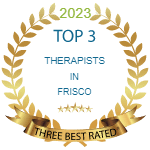Phobias are one of the most common mental illnesses in the United States. The National Institute of Mental Health suggests that 8% of U.S. adults have some type of phobia. Women are more likely to experience phobias than men. Typical symptoms of phobias can include nausea, trembling, rapid heartbeat, feelings of unreality and being preoccupied with the fear object.
The American Psychiatric Association (APA) identifies three different categories of phobias: social phobias, agoraphobia and specific phobias. When people talk about having a phobia of a specific object such as snakes, spiders, or needles, they are referring to a specific phobia.
A–Z List of Some of the More Common Phobias

While not comprehensive, this phobia list offers a glimpse of the many phobias that can have a serious impact on a person’s life. As you may notice while you browse through this list, most specific phobias fall into one of four major categories:
- Fears of the natural environment
- Fears related to animals
- Fear related to medical treatments or issues
- Fears related to specific situations
These names themselves are often formed by taking a Greek prefix that represents the fear object and adding the -phobia suffix. Because of this, any attempt at a completely exhaustive list of phobias would simply be an exercise in futility. Any list of phobias could grow with the addition of newly coined terms for previously unnamed specific phobias.
While listing all of the phobias that may exist is not possible, it can be helpful to look through a list of some of the more commonly described phobias. As you can see by looking at this list, almost any object or situation can become the source of fear.
A
- Achluophobia – Fear of darkness
- Acrophobia – Fear of heights
- Aerophobia – Fear of flying
- Algophobia – Fear of pain
- Agoraphobia – Fear of open spaces or crowds
- Aichmophobia – Fear of needles or pointed objects
- Amaxophobia – Fear of riding in a car
- Androphobia – Fear of men
- Anginophobia – Fear of angina or choking
- Anthrophobia – Fear of flowers
- Anthropophobia – Fear of people or society
- Aphenphosmphobia – Fear of being touched
- Arachibutyrophobia – Fear of peanut butter
- Arachnophobia – Fear of spiders
- Arithmophobia – Fear of numbers
- Astraphobia – Fear of thunder and lightning
- Ataxophobia – Fear of disorder or untidiness
- Atelophobia – Fear of imperfection
- Atychiphobia – Fear of failure
- Automatonophobia – Fear of Human-Like Figures
- Autophobia – Fear of being alone
B
- Bacteriophobia – Fear of bacteria
- Barophobia – Fear of gravity
- Bathmophobia – Fear of stairs or steep slopes
- Batrachophobia – Fear of amphibians
- Belonephobia – Fear of pins and needles
- Bibliophobia – Fear of books
- Botanophobia – Fear of plants
C
- Cacophobia – Fear of ugliness
- Catagelophobia – Fear of being ridiculed
- Catoptrophobia – Fear of mirrors
- Chionophobia – Fear of snow
- Chromophobia – Fear of colors
- Chronomentrophobia – Fear of clocks
- Chronophobia – Fear of Time
- Claustrophobia – Fear of confined spaces
- Coulrophobia – Fear of clowns
- Cyberphobia – Fear of computers
- Cynophobia – Fear of dogs
D
- Dendrophobia – Fear of trees
- Dentophobia – Fear of dentists
- Domatophobia – Fear of houses
- Dystychiphobia – Fear of accidents
E
- Ecophobia – Fear of the home
- Elurophobia – Fear of cats
- Entomophobia – Fear of insects
- Ephebiphobia – Fear of teenagers
- Equinophobia – Fear of horses
G
- Gamophobia – Fear of marriage
- Genuphobia – Fear of knees
- Glossophobia – Fear of speaking in public
- Gynophobia – Fear of women
H
- Haphephobia – Fear of touch
- Heliophobia – Fear of the sun
- Hemophobia – Fear of blood
- Herpetophobia – Fear of reptiles
- Hippopotomonstrosesquipedaliophobia – Fear of long words
- Hydrophobia – Fear of water
- Hypochondria – Fear of illness
I
- Iatrophobia – Fear of doctors
- Insectophobia – Fear of insects
K
- Koinoniphobia – Fear of rooms
- Koumpounophobia – Fear of buttons
L
- Leukophobia – Fear of the color white
- Lilapsophobia – Fear of tornadoes and hurricanes
- Lockiophobia – Fear of childbirth
M
- Mageirocophobia – Fear of cooking
- Megalophobia – Fear of large things
- Melanophobia – Fear of the color black
- Microphobia – Fear of small things
- Mysophobia – Fear of dirt and germs
N
- Necrophobia – Fear of death or dead things
- Noctiphobia – Fear of the night
- Nosocomephobia – Fear of hospitals
- Nyctophobia – Fear of the dark
O
- Obesophobia – Fear of gaining weight
- Octophobia – Fear of figure
- Ombrophobia – Fear of rain
- Ophidiophobia – Fear of snakes
- Ornithophobia – Fear of birds
P
- Papyrophobia – Fear of paper
- Pathophobia – Fear of disease
- Pedophobia – Fear of children
- Philematophobia – Fear of Kissing
- Philophobia – Fear of love
- Phobophobia – Fear of phobias
- Podophobia – Fear of feet
- Porphyrophobia – Fear of the color purple
- Pteridophobia – Fear of ferns
- Pteromerhanophobia – Fear of flying
- Pyrophobia – Fear of fire
S
- Samhainophobia – Fear of Halloween
- Scolionophobia – Fear of school
- Scoptophobia – Fear of being stared at
- Selenophobia – Fear of the moon
- Sociophobia – Fear of social evaluation
- Somniphobia – Fear of sleep
T
- Tachophobia – Fear of speed
- Technophobia – Fear of technology
- Tonitrophobia – Fear of thunder
- Trypanophobia – Fear of needles/injections
- Trypophobia – Fear of Holes
V-Z
- Venustraphobia – Fear of beautiful women
- Verminophobia – Fear of germs
- Wiccaphobia – Fear of witches and witchcraft
- Xenophobia – Fear of strangers or foreigners
- Zoophobia – Fear of animals
Treating a Phobia
Phobias are treated with a combination of therapy and medications.
If you’re interested in finding treatment for your phobia, you should make an appointment with a psychologist or a qualified mental health professional.
The most effective treatment for specific phobias is a type of psychotherapy called exposure therapy. During exposure therapy, you work with a psychologist to learn how to desensitize yourself to the object or situation that you fear.
This treatment helps you change your thoughts and feelings about the object or situation so that you can learn to control your reactions.
The goal is to improve your quality of life so that you’re no longer hindered or distressed by your fear.
Exposure therapy isn’t as scary as it may sound at first. This process is done with the help of a qualified mental health professional, who knows how to guide you slowly through increasing levels of exposure coupled with relaxation exercises.
If you fear spiders, you will begin by simply thinking of spiders or situations where you may encounter one. Then you may progress to pictures or videos. Then perhaps go to a place where spiders may be, such as a basement or wooded area.
It will take some time before you’ll be asked to look at or touch a spider.
Your doctor may recommend certain anxiety-reducing medications that can help you through exposure therapy. While these medications aren’t exactly a treatment for phobias, they can help make exposure therapy less distressing.
Kazmo Brain Center is a counseling center in Frisco, Texas specializing in Phobias and will work with you toward a happier and more satisfying position. If you or your loved ones are facing Phobias and you think that you need help, Request an appointment at the Kazmo Brain Center and we are here to help.
Resources:
verywellmind.com
healthline.com







